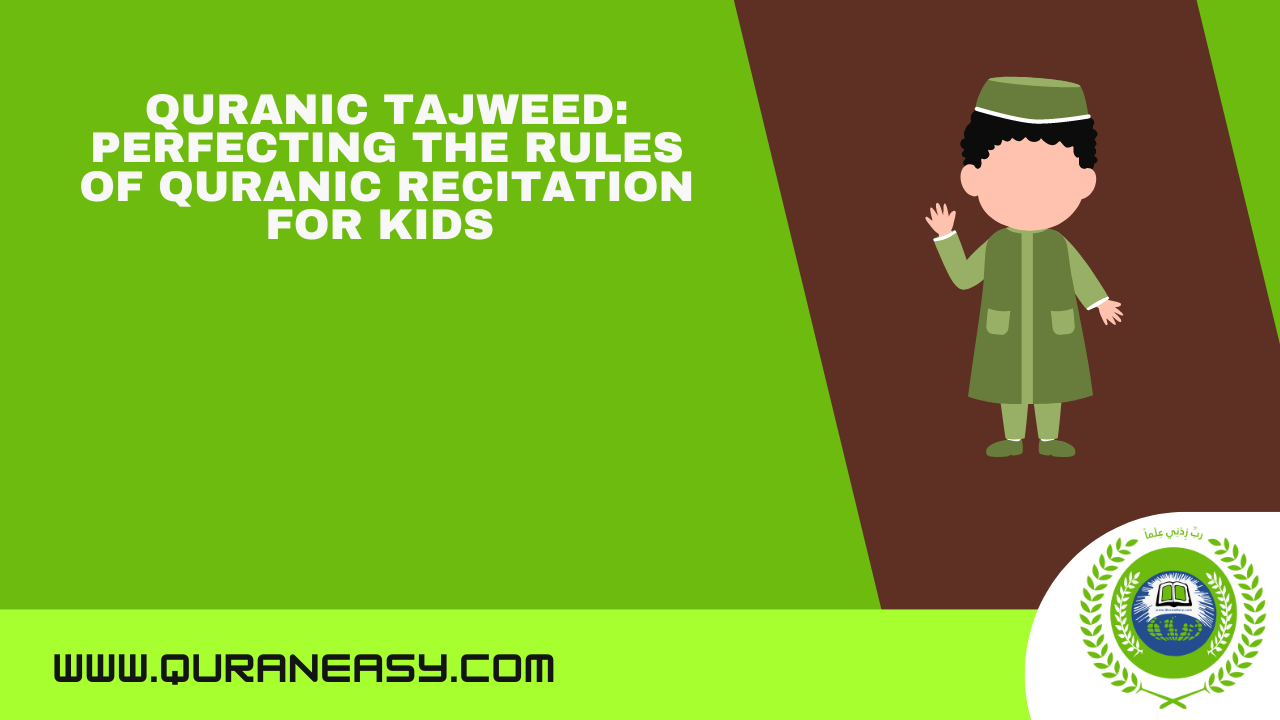Quranic Tajweed is the art of reciting the Holy Quran in accordance with the rules of pronunciation and intonation. It involves perfecting the pronunciation of Arabic letters, and observing the rules of intonation and rhythm. Tajweed is not only important for the correct recitation of the Quran, but it also helps in understanding and retaining the Quranic texts. Teaching Tajweed to kids at a young age can have a significant impact on their Quranic studies and overall character development.
Importance of Tajweed for Kids
The Quran is the most sacred text of Islam, and it is important to recite it correctly and with proper intonation. Tajweed helps in perfecting the pronunciation of each letter and the rhythm of the recitation. When kids learn Tajweed, they are able to recite the Quran with proper accent and intonation, and this enhances their understanding of the Quranic texts. Tajweed also helps in the memorization of the Quran, as kids are able to remember the text better when they recite it with proper intonation.
Quranic Tajweed for Kids – An Overview
Teaching Tajweed to kids can be challenging, but it is also very rewarding. It involves a step-by-step process of learning the rules of pronunciation and intonation, and applying them in recitation. There are two basic categories of Tajweed rules: Basic and Advanced. The basic rules involve the proper pronunciation of Arabic letters, and the advanced rules involve the rules of intonation and rhythm. The following are some of the basic and advanced rules of Tajweed.
Basic Rules of Tajweed for Kids
Arabic Alphabets and Their Pronunciation
The first step in learning Quranic Tajweed is to learn the pronunciation of Arabic letters. Kids need to learn the shape and sound of each letter, as well as the different ways in which each letter can be pronounced. Arabic letters can be pronounced differently depending on their position in a word, and kids need to be taught these variations.
Characteristics of Arabic Letters
The second step in learning Quranic Tajweed is to understand the characteristics of Arabic letters. Arabic letters can be divided into two categories: heavy and light. Heavy letters are pronounced with emphasis, while light letters are pronounced with less emphasis. Kids need to learn the characteristics of each letter, and apply them in recitation.
Rules of Nunation
Nunation is the addition of the sound “n” to the end of a word. There are specific rules for the pronunciation of nunation, and kids need to be taught these rules in order to recite the Quran correctly.
Maddah and Leen Letters
Maddah and Leen letters are elongated and softened letters respectively. These letters have specific rules for their pronunciation, and kids need to be taught these rules in order to recite the Quran correctly.
Qalqalah
Qalqalah is the echoing sound that is produced when a letter is pronounced with a bouncing motion. There are five letters in Arabic that have Qalqalah, and kids need to be taught how to produce this sound correctly.
Lam and Ra Readings
Lam and Ra are two letters in Arabic that have specific rules for their pronunciation. Kids need to be taught these rules in order to recite the Quran correctly.
Advanced Rules of Tajweed for Kids
Tafkheem and Tarqeeq
Tafkheem and Tarqeeq are the rules of pronunciation for heavy and light letters respectively. Kids need to learn these rules in order to produce the proper emphasis in their recitation.
Ikhfa
Ikhfa is the rule of hiding the sound of certain letters in a word. Kids need to be taught this rule in order to recite the Quran correctly.
Idgham
Idgham is the rule of merging two letters together in pronunciation. Kids need to learn this rule in order to produce the correct sound in their recitation.
Izhar
Izhar is the rule of pronouncing certain letters clearly. Kids need to be taught this rule in order to recite the Quran correctly.
Ghunnah
Ghunnah is the nasal sound that is produced when a letter is pronounced with a nasal sound. Kids need to be taught how to produce this sound correctly.
Meem Sakinah
Meem Sakinah is the rule of pronouncing the letter Meem when it appears at the end of a word with a Sukoon (no vowel sound). Kids need to be taught this rule in order to recite the Quran correctly.
How to Teach Tajweed to Kids
Teaching Tajweed to kids requires a lot of patience and effort. The following are some tips for teaching Tajweed to kids:
Creating a Learning Environment
Kids need a comfortable and supportive environment in order to learn Tajweed. Teachers and parents should create a positive learning environment that encourages kids to ask questions and learn at their own pace.
Using Tajweed Books and Guides
There are many books and guides available for teaching Tajweed to kids. Teachers and parents should use these resources to help kids learn the rules of Tajweed in a structured and organized way.
Engaging Kids in Interactive Activities
Kids learn best when they are engaged in interactive activities. Teachers and parents should create fun and engaging activities that help kids learn and apply the rules of Tajweed. This could include recitation games, group recitation, and quizzes.
Encouraging Recitation and Memorization
Recitation and memorization are essential parts of learning Tajweed. Teachers and parents should encourage kids to recite the Quran regularly, and also help them memorize verses and surahs.
Benefits of Tajweed for Kids
Teaching Tajweed to kids has many benefits, including:
Better Understanding and Retention of Quranic Texts
Kids who learn Tajweed are able to recite the Quran with proper accent and intonation, which enhances their understanding of the Quranic texts. They are also able to remember the text better when they recite it with proper intonation.
Improved Pronunciation and Accent
Tajweed helps kids perfect their pronunciation of Arabic letters and their accent, which has a positive impact on their overall communication skills.
Increased Interest in Quranic Studies
Learning Tajweed can help kids develop a deeper interest in Quranic studies, as they learn more about the text and its meaning.
Development of Moral and Ethical Values
The Quran teaches important moral and ethical values, and learning Tajweed helps kids understand and internalize these values.
Challenges in Teaching Quranic Tajweed to Kids
Teaching Tajweed to kids can be challenging due to the following factors:
Language Barriers
Kids who are not fluent in Arabic may find it difficult to learn the rules of Tajweed. Teachers and parents should use simple and clear language, and also provide translations where necessary.
Lack of Resources
There may be a lack of resources available for teaching Tajweed to kids, especially in non-Arabic speaking countries. Teachers and parents should make use of online resources and books to help overcome this challenge.
Short Attention Span
Kids have short attention spans, and may become bored or distracted during Tajweed lessons. Teachers and parents should use interactive and engaging activities to keep kids focused and interested.
Limited Exposure to Quranic Studies
Kids who have limited exposure to Quranic studies may find it difficult to learn Tajweed. Teachers and parents should provide opportunities for kids to recite the Quran and learn about its meaning.
Conclusion
Teaching Tajweed to kids is an important part of their Quranic studies. Tajweed helps kids perfect their pronunciation of Arabic letters, and their intonation and rhythm in recitation. It also enhances their understanding and retention of the Quranic texts, and helps them develop a deeper interest in Quranic studies. While there may be challenges in teaching Tajweed to kids, the benefits are significant and worth the effort.
FAQs
Can Tajweed be Taught to Kids at a Young Age?
Yes, Tajweed can be taught to kids at a young age. In fact, the earlier kids learn Tajweed, the easier it is for them to perfect their pronunciation and intonation.
How Long Does It Take to Learn Tajweed?
The time it takes to learn Tajweed varies depending on the student’s age, language proficiency, and learning style. However, with regular practice and guidance, kids can learn the basics of Tajweed in a few months.
Are There Any Specific Techniques for Memorizing Tajweed Rules?
Repetition and practice are the best techniques for memorizing Tajweed rules. Teachers and parents can also use recitation games and quizzes to help kids memorize the rules.
How Can Parents Ensure That Their Kids Are Learning Tajweed Correctly?
Parents can ensure that their kids are learning Tajweed correctly by monitoring their progress and recitation. They can also attend Tajweed classes with their kids to learn along with them at Quran easy academy’s Online quran classes for kids
Are There Any Online Resources for Teaching Tajweed to Kids?
Yes, there are many online resources available for teaching Tajweed to kids, including interactive lessons, videos, and guides. Some websites also offer Tajweed apps for kids to practice on their own. Parents and teachers can search for these resources and incorporate them into their teaching methods.





Leave A Comment